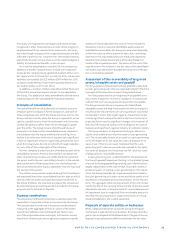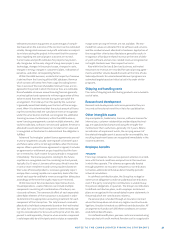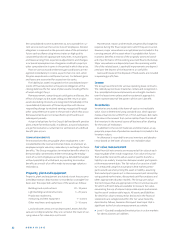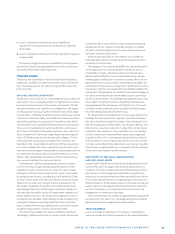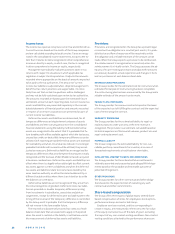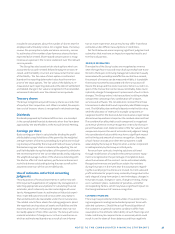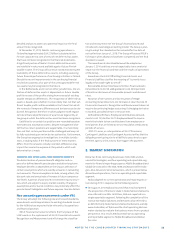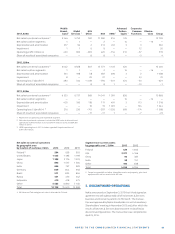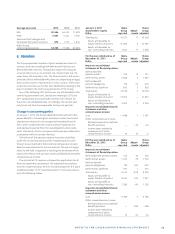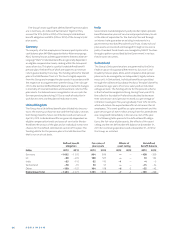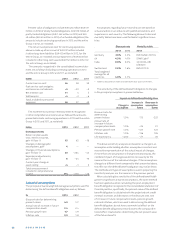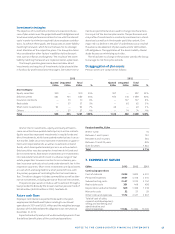Nokia 2013 Annual Report Download - page 40
Download and view the complete annual report
Please find page 40 of the 2013 Nokia annual report below. You can navigate through the pages in the report by either clicking on the pages listed below, or by using the keyword search tool below to find specific information within the annual report.NOKIA IN 2013
38
impact future profi ts. From time to time the Group endeavors
to mitigate this risk through transfer of its rights to the cash
collected from these arrangements to third party fi nancial in-
stitutions on a non-recourse basis in exchange for an upfront
cash payment.
ALLOWANCES FOR DOUBTFUL ACCOUNTS
The Group maintains allowances for doubtful accounts for es-
timated losses resulting from subsequent inability of custom-
ers to make required payments. If the fi nancial conditions of
customers were to deteriorate, reducing their ability to make
payments, additional allowances may be required.
INVENTORY-RELATED ALLOWANCES AND PROVISIONS
The Group periodically reviews inventory for excess amounts,
obsolescence and declines in net realizable value below cost
and records an allowance against the inventory balance for any
such declines. These reviews require management to estimate
future demand for products. Possible changes in these esti-
mates could result in revisions to the valuation of inventory in
future periods. The Group recognizes the estimated liability
for non-cancellable purchase commitments for inventory in
excess of forecasted requirements at each balance sheet date.
RESTRUCTURING PROVISIONS
The Group provides for the estimated future cost related to
restructuring programs. The provision made for restructuring
is based on management’s best estimate. Changes in esti-
mates of timing or amounts of costs to be incurred may be-
come necessary as the restructuring program is implemented.
PROJECT LOSS PROVISIONS
The Group provides for onerous contracts based on the lower
of the expected cost of fulfi lling the contract and the expected
cost of termination the contract. Due to the long-term nature
of customer projects, changes in estimates of costs to be
incurred, and therefore project loss estimates, may become
necessary as the projects are executed.
WARRANTY PROVISIONS
The Group provides for the estimated cost of product warran-
ties at the time revenue is recognized. The Group’s warranty
provision is established based upon best estimates of the
amounts necessary to settle future and existing claims on
products sold as of each balance sheet date. As new prod-
ucts incorporating complex technologies are continuously
introduced, and as local laws, regulations and practices may
change, changes in these estimates could result in additional
allowances or changes to recorded allowances being required
in future periods.
PROVISION FOR INTELLECTUAL PROPERTY RIGHTS (IPR)
INFRINGEMENTS
The Group provides for the estimated past costs related to al-
leged asserted IPR infringements. The provision is an estimate
calculated based on a probable outcome of potential future
settlement. IPR infringement claims can last for varying periods
of time, resulting in irregular movements in the IPR infringe-
ment provision. The ultimate outcome or actual cost of settling
an individual infringement may materially vary from estimates.
LEGAL CONTINGENCIES
Legal proceedings covering a wide range of matters are
pending or threatened in various jurisdictions against the
Group. Provisions are recorded for pending litigation when it is
determined that an unfavorable outcome is probable and the
amount of loss can be reasonably estimated. Due to the inher-
ent uncertain nature of litigation, the ultimate outcome or
actual cost of settlement may materially vary from estimates.
BUSINESS COMBINATIONS
The Group applies the acquisition method of accounting to
account for acquisitions of businesses. The consideration
transferred in a business combination is measured as the ag-
gregate of the fair values of the assets transferred, liabilities
incurred towards the former owners of the acquired business
and equity instruments issued. Identifi able assets acquired
and liabilities assumed by the Group are measured separately
at their fair value as of the acquisition date. Non-controlling
interests in the acquired business are measured separately
based on their proportionate share of the identifi able net
assets of the acquired business. The excess of the cost of the
acquisition over Nokia’s interest in the fair value of the identifi -
able net assets acquired is recorded as goodwill.
The allocation of fair values to the identifi able assets
acquired and liabilities assumed is based on various valuation
assumptions requiring management judgment. Actual results
may diff er from the forecasted amounts and the diff erence
could be material. See also Note .
ASSESSMENT OF THE RECOVERABILITY OF LONG-LIVED
ASSETS, INTANGIBLE ASSETS AND GOODWILL
The recoverable amounts for long-lived assets, intangible
assets and goodwill have been determined based on the ex-
pected future cash fl ows attributable to the asset or cash-gen-
erating unit discounted to present value. The key assumptions
applied in the determination of recoverable amount include
discount rate, length of an explicit forecast period, estimated
growth rates, profi t margins and level of operational and capi-
tal investment. Amounts estimated could diff er materially from
what will actually occur in the future. See also Note .
INCOME TAXES
Management judgment is required in determining current
tax expense, uncertain tax positions, deferred tax assets and
liabilities and the extent to which deferred tax assets can be
recognized. Each reporting period deferred tax assets are
assessed for realizability and when circumstances indicate it
is no longer probable that deferred tax assets will be utilized,
they are adjusted as necessary. In the event any deferred
tax assets are to be re-recognized, they would be subject to



